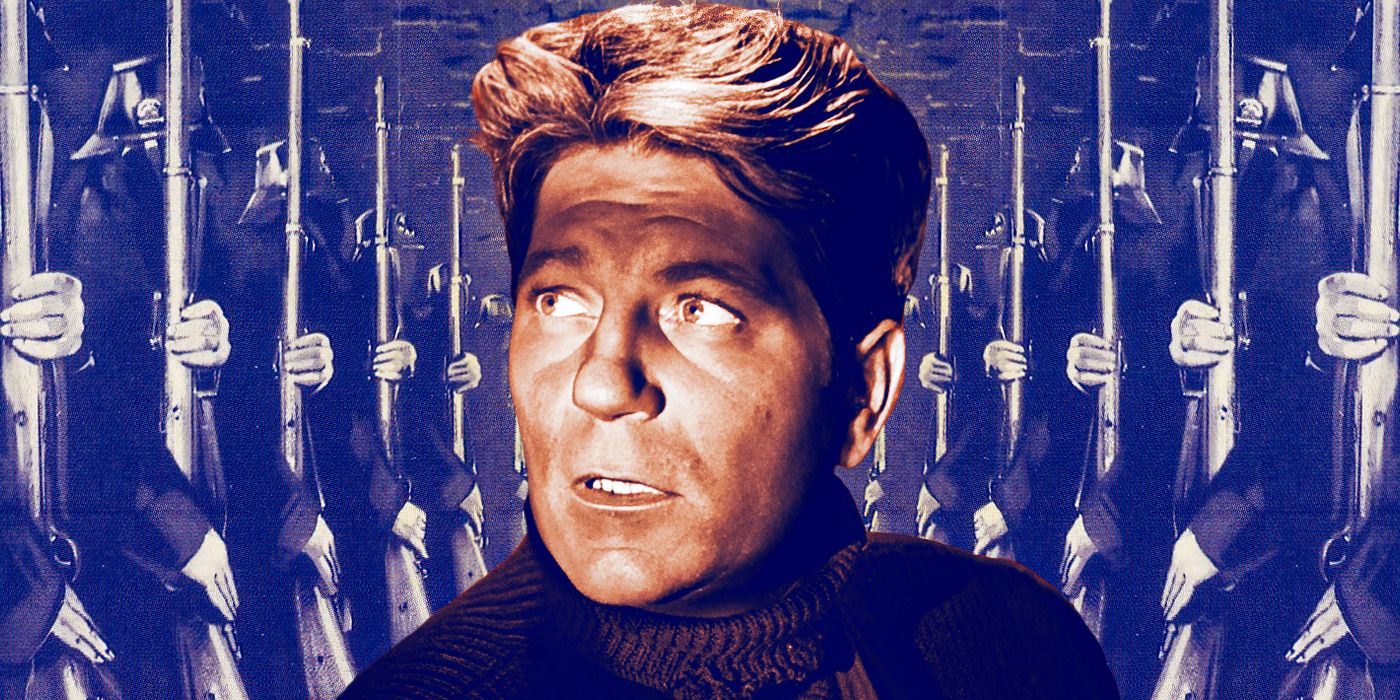The Big Picture
- Emir Kusturica’s film
Underground
defies genre categorization, blending war, comedy, fantasy, and romance in a cinematic masterpiece. -
Underground
showcases Kusturica’s talent for creating chaos and beauty on celluloid, drawing inspiration from Federico Fellini and Andrei Tarkovsky. - The film’s purposeful direction infuses every frame with intentional choreography, eccentric actions, and surreal humor, creating an unforgettable experience.
There is no film quite like Emir Kusturica‘s 1995 masterpiece Underground. It defies any sort of genre categorization: not only is it one of the best war films of all time, it is also a romantic comedy, a fantasy film, and a historical political allegory film with undertones of symbolism, all in one. It’s a film you’ll either love or hate, but regardless of your taste, it’s one that you will never forget. With each frame reflecting an impressionist canvas that is so beautifully etched in every department, Underground is a piece of art that finds beauty in chaos, showing off Kusturica’s gift of realizing the fullness of life and all its fantasies on celluloid. Kusturica, who registered his name among the most distinguished European filmmakers in the late 20th century, draws his inspiration from legendary directors Federico Fellini and Andrei Tarkovsky, whose pictures are known to create an unforgettable bond with audiences. “I am just inheriting the cinema that my old idols used to do,” Kusturica said in an interview, referring to the two legends and others he learned from. Just like his influences, Kusturica’s films are keen to mesmerize audiences, leaving them with a lingering sense of wonder and a longing for something yonder.
Rather than going for the poetic silence of Fellini’s Oscar-winning feature La Strada, Kusturica switches things up in Underground. He combines the poetic vibes that La Strada (and many of Tarkovsky’s films) offers with the playful and often eccentrically choreographed elements seen in Fellini’s other paragons, such as Juliet of the Spirits and La Dolce Vita, to create a uniquely Kusturica-esque picture. In Underground, he creatively uses the camera, music, lighting, dialogue, and subjects to weave one of the most heartbreaking historical stories of a country into a surprisingly, refreshingly light tone. Winner of the 1995 Cannes Film Festival, which was Kusturica’s second at the event after the Academy Awards-nominated When Father Was Away on Business bagged the award in 1985, Underground is wonderfully insane, with electrifying performances and plot twists that remain unpredictable throughout. As the film’s epilogue states that it’s a story without a definite ending, Underground is an absolutely bonkers film that challenges every aspect of conventional storytelling. It’s a symbolic picture that leaves you in awe of cinema’s infinite potential to create art that challenges the status quo.
What Is ‘Underground’ About?
Also known by the subtitle Once Upon a Time There Was One Country, Underground tells the story of Yugoslavia from the beginning of World War II to the wars leading to its disintegration in the 1990s through the lived experiences of two fictional friends. The film’s outlandish beginning sets the tone that the film adopts in its roller coaster of a journey. With a parrot perched on his shoulder, the adorable, cognitively-impaired, and stuttering zoo animal owner Ivan (Slavko Štimac) excitedly beckons his brother Marko (Miki Manojlović) and Marko’s friend Blacky (Lazar Ristovski) into the house. The camera cuts to Blacky and Marko, the lead characters in the film, and their bizarre entourage returning from a drunken night spree. Bellowing at the top of their voices while indiscriminately shooting in the air atop a horse-drawn cart that they can barely balance on, with a ridiculously energetic brass band escorting them, the film declares it’s not going to be an ordinary ride. The bullets that almost stray into members of the entourage sound the alarm for the danger that lurks ahead in Undeground, as well as the fun that it promises along the way, and the unpredictability that only Kusturica can provide. As the story unfolds, it is revealed through Marko’s dialogue with Blacky’s heavily pregnant wife Vera (Mirjana Karanović) that Marko has enrolled Blacky in their nationalistic Communist Party to help fight off the fascist Nazi occupiers.
Set in Belgrade and narrated in three parts, the first part marks the characters’ experience of World War II. The film’s initial attack by the Nazis, in an oddball kind of humor, hilariously finds Blacky squabbling with hiswife (Vera), who is angry at him for having an affair with a renowned actress (Mirjana Joković). On the other hand, a fervent womanizing Marko does not even notice the bombs as he is caught in the act, high as a kite, having sex with a prostitute. For poor Ivan, he witnesses the horrors of his life as his beloved animals are torn apart by shrapnel, and others are released from the zoo by Nazi bombs. His only memorabilia for his lifelong animal caregiver career is an attention-seeking young chimpanzee he salvages. Blacky soon realizes that his mistress Natalija is romantically involved with a German Nazi officer and plans an elaborate eloping mission with her. As he is wanted by the Nazis for his involvement in the resistance, Marko convinces Blacky to stay in their weapon-manufacturing underground bunker, where Marko will supply him with all the necessities during the period of war until it is safe to come out. Political situations change, and the war is soon over. However, Marko doesn’t inform Blacky and his underground team of the surface events, and they continue to live in the bunker as they manufacture weapons, which Marko profits from. Meanwhile, Marko also betrays Blacky by marrying Natalija, even as he continues to deceive Blacky. The second and third chapters focus on the characters’ experiences during the events of the Cold War and the Yugoslav Wars of the 1990s.
‘Underground’ Is a Hallucinogenic Picture that Defies Categorization
Underground is not a film that confines itself to any genre category. As a war film, it delves into three wars across half a century: World War II, the Cold War, and the Yugoslav Wars. Simultaneously, it is a fantastical historical film capturing real-life events of these wars. Covering World War II, the film explores the rise of Yugoslav nationalists and The Communist Party against the occupying Nazi fascists. Through Blacky and Marko, the film delves into the independence struggles of the Yugoslavs against a barbaric regime that sought to dominate even the most personal aspects of their lives. The film also portrays the rise of Yugoslav political figures like Josip Broz Tito and partially comments on their leadership, though it is not entirely a film about history and the struggle itself.
Kusturica’s patriotism and longing for a united country are evident in the film’s nostalgic narrative of a united Yugoslavia. Speaking about the making of the film, Kusturica stated, “In my family, in every generation they are changing countries, and I am fed up with this. I was born Yugoslav and I am going to die a Yugoslav.” Kusturica, however, faced criticism for not covering some of the atrocities committed by the regimes and the sharp ethnic divisions that emerged during the period his film is set, something that affected him to the point of almost quitting filmmaking.

Related
The First Foreign Language Best Picture Nominee Is Also One of The Greatest War Films Ever Made
Jean Renoir’s anti-war masterpiece will forever endure.
As a romance film, one of Underground‘s central plots is the love triangle between Marko, Blacky, and Natalija. Blacky starts off as a philandering married man whose heart is stolen by Natalija’s charm, something that Marko also finds hard to resist. While Blacky believes he is Natalija’s soulmate, Marko falls head over heels in love with her, changing from a carefree womanizer to a serially faithful lover, albeit in a romance he keeps hidden from Blacky. It’s an intriguing entanglement of betrayal, greed, love, and moral decadence. Romance is a theme that Kusturica uses extensively in the film to drive its plot. There are grand weddings and festivities centered around romance, including a grandiose island wedding. Weaving fantastical elements into the narrative, this island detaches itself from the mainland. The sequence is also a reunion of the film’s Yugoslav characters at a feast in what appears like the afterlife, where they aren’t fighting but living in perfect harmony. Kusturica uses surrealism symbolically. The island drifting away could be read to represent the disintegration of Yugoslavia, while the afterlife fantastical wedding is a nostalgic representation that asks, “What if Yugoslavia’s unity had stood the test of time? What if the terrible wars hadn’t happened?”
Underground is absurdly humorous and deftly uses humor to lighten otherwise serious matters. But the humor isn’t always a light-hearted tool; sometimes it’s delivered unexpectedly and in a slapstick way or with deadpan wit. Whether it’s a man guy dusting off his shoes with a screaming cat’s fur or another biting a live electric wire with his teeth, Underground is consistently bold in its execution. In the interview about the making of the film, Kusturica said that while his films often attempts to be comedic, sometimes they fall short on that front, but he found Underground‘s script (which he co-wrote with Dušan Kovačević) particularly accommodating for his style of humor.
Emir Kusturica’s Directing in ‘Underground’ Is a Stand-Out
If there’s an obvious stand-out element in Underground, it’s its purposeful direction. On a closer look, everything in each of the film’s frames is intentional. Whether it’s choreographed body movements, topsy-turvy shots, or eccentric actions like a particularly memorable scene where Marko and Natalija romantically tease each other to the nostalgia-inducing rhythmic tune of Goran Bregovic‘s feel-good anthem “Ringe Ringe Raja”. The juxtaposition between their life of opulence, which Kusturica emphasizes with intercuts of shots between their dance – which is reminiscent of Fellini’s iconic 8½ scene, which, interestingly, inspired Quentin Tarantino’s Pulp Fiction dance – and Blacky’s face in the hidden cameras they have planted to monitor him, and the rat-like life that Blacky and his men live beneath them is commentary on how independence yielded different results for Yugoslavs.
Marko represents the political elites of the new status who continue to exploit compatriots like Blacky. It is how Kusturica marries all these elements with his immaculate cinematography that creates an undeniable energetic vibe to the film, even without necessarily investing in its plot. Kusturica was driven by a desire to make a masterpiece that takes the best out of 20th-century cinema, revealing in his interview, “If I speak about this film, I would rather speak about the energy and certain references in the history of cinema because we are in the end of the century, rather than (discuss whether it is) a strong story.”
Despite its limited theatrical release, Underground‘s bold direction, surreal humor, and intricate storytelling creates an unforgettable experience of a cinematic tour de force that deserves your attention.
Underground is currently available to stream on Kino Film Collection in the U.S.
WATCH ON KINO FILM



